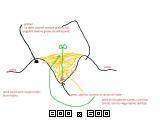Not really a small garden, but i hope i can help you.
We've done a sunken biomass garden in a sub-mediterranean climate with 800mm rainfall, raining mostly in winter time, in summer almost no rain.
It's close to 100m2 surface dug a meter deep with machine.
Then we placed down a lot of biomass - twigs, branches, rotten poles, lots of goat bedding (shit and straw).
Then chunks of grass/soil and on top of that clean soil +
compost.
It was planted right away with salad mixture without mulch.
Other beds were heavily mulched with goat bedding and seeded with zucchini seeds in individuals holes in the mulch, later also planted with seedlings of tomato and others.
Goat bedding mulch is great as it's not dry mulch but has lots of moisture which really is important for summer time.
Garden surface is half a meter below original surface area, paths are as close to garden surface and they also have biomass, the whole area is biomass filled, so in winter time this area will get plenty of water acting like a sponge and hopefully helping the garden in summer.
Wind is another factor that dries the garden.
On north we have a forest windbreak, on north east, east and west side there is windbreak made out of biomass and material that was extra (stones, rocks, soil etc.)
We also planted mounds with shrubs and trees (edibles and pioneers) for extra windbreak.
What we are also doing is planting trees on west berm so we shade the strong afternoon sun, so plants can go to rest a bit early.
We like the results!
Another idea i like is this one (drawing, text is in slovenian but you will get the idea).
Diggin as deep as possible, making berms on both sides and using trench filled with mulch for growing area in summer.
Planting is done as deep as possible.
Berms are acting as water flow function, windbreak.
Also here we can't grow winter veggies inside the trench as it's to wet, so we can use the berms.
Berms can be also hugelculture, they work great here in winters.
Here is Geoff explaining the making of hyper arid sunken garden in Jordan.
http://www.youtube.com/watch?v=Xa2Kp6Q095g
Watch the suggested videos also.
Happy gardening!





 1
1









 1
1




 1
1









 1
1






















